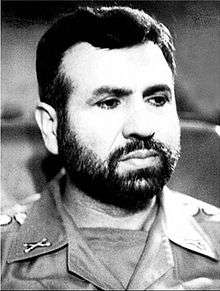Mousa Namjoo
Sayyid Mousa Namjoo (Persian: موسی نامجو, 17 December 1938 – 29 September 1981) was an Iranian military officer who served as the minister of defence and armed forces logistics.
Mousa Namjoo | |
|---|---|
 | |
| Minister of National Defence | |
| In office 17 August 1981 – 29 September 1981 | |
| President | Mohammad-Ali Rajai |
| Prime Minister | Mohammad-Javad Bahonar Mohammad Reza Mahdavi Kani |
| Preceded by | Javad Fakoori |
| Succeeded by | Mohammad Salimi |
| Personal details | |
| Born | 17 December 1938 Bandar-e Anzali, Iran |
| Died | 29 September 1981 (aged 42) Kahrizak District, Tehran, Iran |
| Nationality | Iranian |
| Alma mater | Officers' School |
| Military service | |
| Allegiance | Iran |
| Branch/service | Ground Force |
| Years of service | 1958–1981 |
| Rank | Colonel[1] |
| Battles/wars | Iran–Iraq War |
| Awards | |
Biography
Namjoo was born in Bandar-e Anzali on 17 December 1938.[2] He graduated from Imam Ali Military University.[3] He was married and had three children.[4]
He worked at the National Military Academy with the rank of colonel.[5][6] He was instrumental in developing a cooperation between the Iranian Revolutionary Guards Corps and army before and during the Iran Iraq war.[6] He also fought in the war.[7] He was also appointed minister of defence and armed forces logistics to the interim government led by Prime Minister Mohammad Reza Mahdavi Kani on 2 September 1981.[8]
Death
Namjoo was killed in a plane crash together with 80 other people on 29 September 1981 near Tehran.[5][7][9] The aircraft was a US-made C-130 Hercules transport plane.[10][11] Other leading military figures killed in the crash were Valiollah Fallahi, Javad Fakoori and Yousef Kolahdouz.[12][13] On 1 October 1981, a funeral service was held for Namjoo and other victims at the military academy in Tehran.[10]
Legacy
A book, entitled A Man with Orange Color, was published by Ezzatollah Alvandi in 2005 concerning Namjoo's biography.[14]
References
- Nikola B. Schahgaldian, Gina Barkhordarian (March 1987), The Iranian Military Under the Islamic Republic (PDF), RAND, ISBN 0-8330-0777-7, retrieved 15 January 2017
- Alvandi, Ezzatolah (2005). مردی به رنگ پرتقال (شهید سید موسی نامجو) (in Persian). Tehran: Shahed. ISBN 964-394-210-4.
- شهید سرلشکر موسی نامجوی وبگاه رسمی وزارت دفاع ایران] Ministry of Defence
- خاطراتی ازشهید سرتیپ خلبان سید موسی نامجو وبگاه رسمی مرتضی آوینی] Aviny
- "The Revolutionary Period". Country Data. Retrieved 20 June 2013.
- "National security". Pars Times. Retrieved 24 August 2013.
- Kiefner, John (1 October 1981). "4 military chiefs in Iran are killed in a plane crash". The New York Times. Beirut. Retrieved 20 June 2013.
- Hosseini, Mir M. "Interim Government Formed". Fouman. Retrieved 20 June 2013.
- "Chronological Listing of Iranian Losses & Ejections". History. Archived from the original on 30 July 2017. Retrieved 20 June 2013.
- "Crash kills Iranian military leaders". Herald Journal. Beirut. AP. 1 October 1981. Retrieved 20 June 2013.
- "103 Reported Killed as Iranian Army Plane Crashes; Altimeter Suspected". Los Angeles Times. Tehran. 4 November 1984. Retrieved 20 June 2013.
- "Iranian military aircraft crashes". Sarasota Journal. UPI. 30 September 1981. Retrieved 20 June 2013.
- Sepehr Zabir (25 February 2011). Iran Since the Revolution (RLE Iran A). Routledge. p. 194. ISBN 978-0-415-61069-8. Retrieved 24 August 2013.
- "Biography of Martyr Namjoo". Tehran: Shahed. 16 September 2005. Retrieved 27 June 2013.